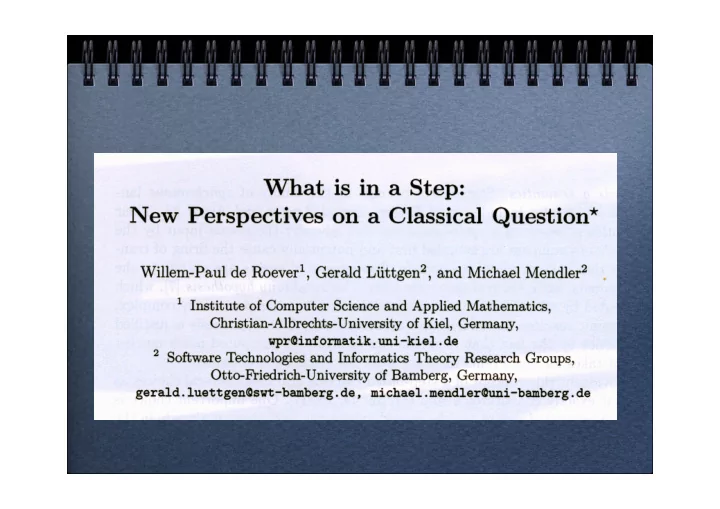

Point of Departure : Pnueli & Shalev’s 1991 paper “What’s in a Step: On the semantics of Statecharts” Pnueli and Shalev show how, while observing global consistency and causality, the synchronous language Statecharts can be given coinciding operational and declarative (i.e., fixed point) step semantics Over the past decade, this semantics has been supplemented with order-theoretic, fully abstract and compositional denotational, axiomatic and game-theoretic semantics and used to emphasize the close connection with Esterel and logic programming (subject of talk) This reveals the Pnueli-Shalev step semantics as a rather canonical interpretation of the synchrony hypothesis
Short intro to Statecharts A hierarchical, concurrent Mealy machine Basic states hierarchically refined by injecting other Statecharts Composite states of 2 possible sorts: and-states and or- states And-states permit parallel and or-states sequential decomposition An and-state is active if all its substates are active, an or-state if exactly one of its substates is active Set of active states during execution called a configuration
The synchrony hypothesis Statecharts belongs to the family of SYNCHRONOUS languages (s.a. Esterel, Signal, Lustre, Argos) Semantics based on a cycle-based reaction, in which events output by the system’s env. are sampled first and pot. cause the firing of transitions that may produce new events Generated events output to the env. when the reaction ends SYNCHRONY HYPOTHESIS ensures that: this complex non-atomic step bundled into ONE ATOMIC STEP Justification: reactions computed quicker than time it takes for new events to arrive from the system’s env
What exactly constitutes a step? Are generated events sensed only in the next step, or already in the current step, and thus trigger the firing of further transitions? First option: Harel’s official non-compositional “semantics A” implemented in Statemate Second option: A step involves a causal chain of firing transitions: A transition fires if its positive triggers (offered by env or generated by a trans. fired previously in the same step) are present and its negative triggers are absent (i.e., not present)
What exactly constitutes a step (cont’d)? Thus, when it fires, a transition may, as part of its action, BROADCAST new events, which, by the principle of CAUSALITY, may trigger further transitions Only when this chain reaction of firing transitions comes to a halt is a step COMPLETE, and, acc. to the synchrony hypothesis, an atomic entity This semantics is NONCOMPOSITIONAL, since bundling a trans. into an atomic step implies forgetting the transition’s causal justification Also, it is not GLOBALLY CONSISTENT, as it permits the same event to be both present and absent within the same step: an event that occurs negatively in the trigger of one firing transition MAY BE GENERATED BY A TRANS. THAT FIRES LATER IN THE SAME STEP
Pnueli & Shalev’s contribution In Pnueli and Shalev’s words, “a proven sign of healthy and robust understanding of the meaning of a programming or specification language is the possession of both an operational and declarative semantics, which are consistent with one another” They showed that adding global consistency is the key to achieving this ambitious goal for Statecharts The resulting operational semantics relies on an iterative FIXED- POINT CONSTRUCTION over a non-monotonic enabledness function for transitions This construction ensures causality but involves backtracking once a global inconsistency is introduced Their declarative semantics for Statecharts identifies the desired fixed point of the enabledness fu thru the notion of SEPARABILITY
Intro to Statecharts (cont’d) Statechart steps defined relative to a configation C and a set E of events given to the system by its environment Key to a step are transitions t each of which is labeled by two sets of events: a trigger trg(t) and an action act(t) Trigger trg(t)=P,N co split into positive events P ⊆ ∏ and negative events N ⊆ ∏ co . t is enabled and thus fires if the set E ⊆ ∏ is such that all events of P, but NONE of N, are in E, i.e., P ⊆ E and N ∩ E= ∅ The effect of firing t is the generation of all events in the action act(t) of t, where a transition’s action act(t) consists of positive events only
Pnueli-Shalev Semantics
Operational semantics
Recommend
More recommend